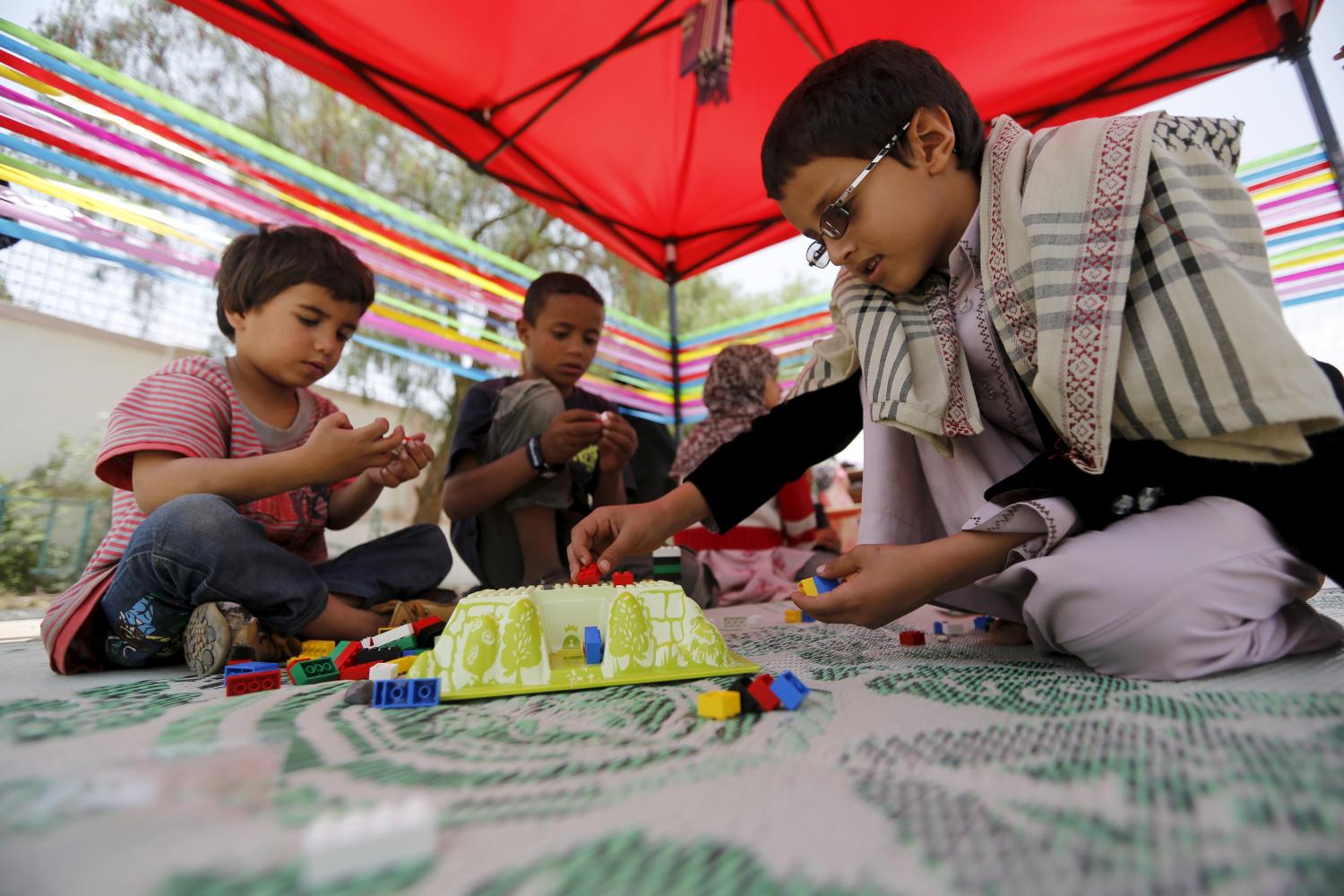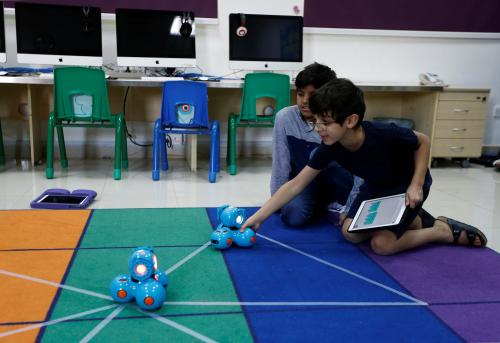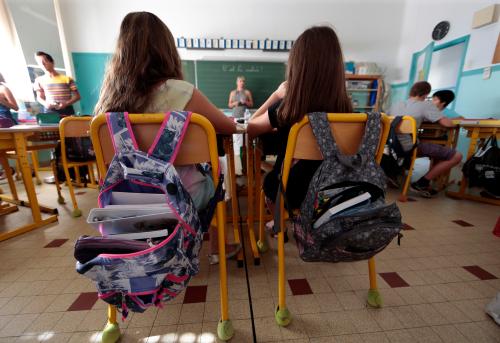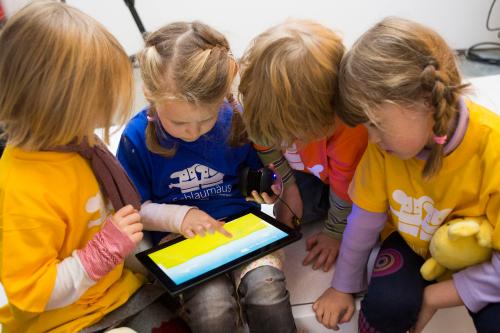Rebecca Winthrop authored this policy brief with Lauren Ziegler, Rhea Handa, and Foluyinka Fakoya.
We are born with the natural ability to gain skills through play. As children, we learn about social norms, roles and responsibilities, and language through curiosity-driven, playful interactions and activities. Learning through play harnesses the power of children’s imagination and inspires active engagement with the material.
At the Center for Universal Education at Brookings, we are studying innovations that strive to improve education. If the education sector stays on its current trajectory, half of all youth around the world entering the workforce in 2030 will lack basic secondary-level skills they need to thrive—from literacy and numeracy to critical thinking and problem solving.1 We believe that leapfrogging, or rapid nonlinear progress, is needed to change this trajectory.
Education that allows students to leap forward in learning should incorporate experimentation and iteration, helping students make meaning of what they are learning, and engage with others in doing so. These types of student-centered, playful learning experiences are an essential component to leapfrogging in education because, without them, young people will not be able to develop the full breadth of competencies and skills they need to thrive in a fast-changing world.
This paper is the first in in a series of Leapfrogging in Education snapshots that provide analyses of our global catalog of education innovations. This research is explained in depth in our book, “Leapfrogging Inequality: Remaking Education to Help Young People Thrive.”
Of the nearly 3,000 innovations captured in our catalog, two-thirds involve playful learning, which represents the largest category of innovations we recorded.
What Is Playful Learning?
Playful learning is driven by student inquiry and needs, is meaningfully connected to students’ lives, and fosters experimentation and social interaction.2 This type of learning can occur through various pedagogical practices such as project-based learning, where children develop knowledge by exploring a real-world problem, as well as personal learning experiences, where students set their own goals and teachers act as facilitators and guides on the learning journey. Playful learning is appropriate for learners of all ages and goes beyond merely interactive activities to require students’ conscious engagement and reflection and allow room for investigation and iteration.3 Numerous studies show that these types of pedagogies result in better student outcomes than more traditional teaching practices.4
| Logics Academy in Canada uses experiential learning through robotics and coding that allows students to actively experience and reflect on their learning. Through this program, students build programmable robots; strengthen their science, technology, engineering, and mathematics (STEM) knowledge; and develop their collaboration and creativity skills.5 |
Catalog Analysis
Our global catalog provides a window into innovations around the world. To develop the catalog, we looked to 16 “innovation spotter” organizations with active lists of education innovations in 2016 and early 2017. From these 16 sources, we identified 2,854 innovations including NGO projects, for-profit products, government initiatives, and schools in 166 countries and 4 languages. We identified more than two-thirds of innovations in the catalog as playful learning innovations (a total of 1,912), and an in-depth analysis of them is provided below. It is important to note that the catalog and this snapshot do not represent the universe of all innovations but do provide insight into trends and areas of opportunity for the education community.
| In India, Dream a Dream’s after school Life Skills Programme promotes the acquisition of knowledge through creativity and expression, and encourages the development of empathy and curiosity for young people from vulnerable backgrounds.6 Using an embodied learning approach that connects sports and arts with learning, Dream a Dream reports that 9 out of 10 young people in their program improve their life skills score—defined as the ability of young people to take initiative, interact with one another, solve problems, manage conflict, and understand and follow instructions—by at least one point each year.7 |
Who is Involved in Playful Learning Innovations?
 Of the 1,912 playful learning innovations in our catalog, 1,122 (59 percent) are implemented by NGOs. The private sector accounts for one quarter of implementers, while governments make up only 15 percent of implementers. A smaller number of innovations is implemented by other organizations, including religious organizations or by nonprofit centers in collaboration with government or private partners.
Of the 1,912 playful learning innovations in our catalog, 1,122 (59 percent) are implemented by NGOs. The private sector accounts for one quarter of implementers, while governments make up only 15 percent of implementers. A smaller number of innovations is implemented by other organizations, including religious organizations or by nonprofit centers in collaboration with government or private partners.
Who Funds Playful Learning Innovations?
 Innovations are often funded by multiple sources, as is the case with the innovations in our catalog. Eighty-four percent of the playful learning innovations we cataloged had information on their sources of funding. Of these, governments proved to be the largest source of funds, supporting 581 innovations. The second largest source of funding was user fees. Of the 562 innovations that charge user fees, most are implemented by private sector actors or individual schools and school networks. Philanthropic organizations are the third largest funders supporting playful learning innovations and stand in contrast with international aid agencies, which only support 151 of the playful learning innovations in our catalog.
Innovations are often funded by multiple sources, as is the case with the innovations in our catalog. Eighty-four percent of the playful learning innovations we cataloged had information on their sources of funding. Of these, governments proved to be the largest source of funds, supporting 581 innovations. The second largest source of funding was user fees. Of the 562 innovations that charge user fees, most are implemented by private sector actors or individual schools and school networks. Philanthropic organizations are the third largest funders supporting playful learning innovations and stand in contrast with international aid agencies, which only support 151 of the playful learning innovations in our catalog.
Who Are the Beneficiaries of Playful Learning Innovations?
Most innovations within our catalog provide services to multiple categories of beneficiaries spanning various income, geographic, and cultural groups. That said, students from low-income households are the most often served group of beneficiaries. Of the 64 percent of playful learning innovations in our catalog that identified specific groups of learners, 817 innovations serve low-income children, 350 serve middle-income children, and 222 serve high-income children. Children from rural and urban areas benefit from similar numbers of playful learning interventions, with 349 interventions serving rural children and 372 serving urban children. While only 133 playful learning innovations identified girls as a specific beneficiary group, many innovations use a coed approach and strive for gender balance, allowing girls to benefit from the majority of playful learning innovations within the catalog. However, very few playful learning innovations focus on some of the most vulnerable children—child laborers (29), displaced children (42), and children in conflict (38)—highlighting a major gap in the provision of such interventions.
| U.S.-based nonprofit Code.org has created a program called CS Discoveries, which introduces computer science concepts into middle-school classrooms. Implemented in over 5,000 public-school classrooms across the United States,8 CS Discoveries introduces students to topics such as programming, physical computing, HTML/CSS, and data. CS Discoveries supports the development of computational thinking, which uses technology as a platform for developing a problem-solving mindset in students.9 |
What Ages Are Playful Learning Innovations Focused On?
 Primary school-aged children are the largest age group served by playful learning innovations, followed by secondary school age-students, though many innovations focus on more than one category of learners.
Primary school-aged children are the largest age group served by playful learning innovations, followed by secondary school age-students, though many innovations focus on more than one category of learners.
Where in the World Are Playful Learning Innovations?
Innovations that employ playful learning methods exist in every region of the world. Above are the 28 countries where we found at least 20 innovations that use playful learning. At 445, the United States has the greatest number of innovations, more than twice the number of innovations in India, which has the second highest amount.
Playful learning innovations in our catalog are more common in high- and middle-income countries, though 19.4 percent of innovations occur in low-income countries.
 Of the 166 countries included in our catalog, 27 countries had only one playful learning innovation: Angola, Algeria, Barbados, Brunei, Cape Verde, Central African Republic, Croatia, Cuba, Djibouti, Equatorial Guinea, eSwatini (formerly Swaziland), Guinea-Bissau, Guyana, Iran, North Korea, Kyrgyzstan, Libya, Macao, Madagascar, Mauritania, Mongolia, Sao Tome and Principe, Seychelles, Somalia, Syria, Tajikistan, Timor-Leste, and Vietnam. In 7 countries—Estonia, Georgia, Grenada, Guam, Maldives, Moldova, and Myanmar—there were no playful learning innovations reported in our catalog (though other non-playful learning innovations were reported in these countries).
Of the 166 countries included in our catalog, 27 countries had only one playful learning innovation: Angola, Algeria, Barbados, Brunei, Cape Verde, Central African Republic, Croatia, Cuba, Djibouti, Equatorial Guinea, eSwatini (formerly Swaziland), Guinea-Bissau, Guyana, Iran, North Korea, Kyrgyzstan, Libya, Macao, Madagascar, Mauritania, Mongolia, Sao Tome and Principe, Seychelles, Somalia, Syria, Tajikistan, Timor-Leste, and Vietnam. In 7 countries—Estonia, Georgia, Grenada, Guam, Maldives, Moldova, and Myanmar—there were no playful learning innovations reported in our catalog (though other non-playful learning innovations were reported in these countries).
Supporting Teachers
Successful leapfrogging in education depends on freeing up teachers’ time so they can focus on pedagogy. Playful learning innovations incorporate elements that support teachers 80 percent of the time. This might mean that students engage in hands-on activities with other members of the community or use a technological tool with a playful, active, or experiential component— both scenarios free up teacher time to concentrate on lesson planning or other direct teaching duties. For example, in Ghana and Uganda, Lively Minds trains both kindergarten teachers and volunteer mothers to lead play-based learning exercises for young children in government schools located in rural communities. The trained mothers then support teachers by assisting during kindergarten sessions.10 In 2016, an independent evaluation found that Lively Minds improved children’s cognitive skills in an effective, low-cost way, while also providing social and health benefits.11 In addition, interventions that provide learning analytics support teachers by providing insightful feedback on student progress and challenges and allow teachers to tailor their lessons. Another way in which playful learning interventions support teachers is by encouraging team teaching, which is when two or more teachers collaborate on lesson planning and delivery. This helps promote dialogue in classrooms and provides additional information for comprehensive student evaluations, while allowing teachers to share ideas and support each other.12
In addition, interventions that provide learning analytics support teachers by providing insightful feedback on student progress and challenges and allow teachers to tailor their lessons. Another way in which playful learning interventions support teachers is by encouraging team teaching, which is when two or more teachers collaborate on lesson planning and delivery. This helps promote dialogue in classrooms and provides additional information for comprehensive student evaluations, while allowing teachers to share ideas and support each other.12
Technology Use
Technology can be combined with playful learning methods in many ways. Gamification is a common way these two tools can work together: Many innovations include software or a website with an educational game. Technology can also enhance hands-on research projects and connect students to communities and experts in participatory ways. Fifty-three percent of playful learning innovations in our catalog also involve the use of technology in some way.
Fundi Bots, a robotics program in Uganda, uses a hands-on, engaging model to teach students how to build robots and provides practical Science, Technology, Engineering, and Math (STEM) education to children in the classroom. Through a network of 75 schools that reaches over 4,500 students, Fundi Bots has enabled diverse groups of students to go beyond passively consuming technology and become creators.13
| The Literacy and Math Education Labs (LEMA) in South America provide board games and puzzles that help students master vital skills such as literacy and numeracy. This gamification approach uses the ability of games to motivate students and connects games to educational lessons.14 LEMA’s no-tech games do not require internet or electricity. The games and lessons can be facilitated by teachers, but also by mothers, peers, or other leaders within the community, adding flexibility to their application. LEMA’s approach encourages active learning of both academic subjects and skills such as collaboration and communication.15 |
Students frequently use the internet to engage with technology through playful learning., which can include watching videos and navigating interactive modules to guide students’ learning. A frequent supplement to this is the use of learning analytics, which allow teachers to adjust ongoing learning programs as necessary. For example, MangaHigh, a virtual learning environment offering math games and adaptive quizzes, provides teachers with data that allow them to gain immediate insight into student understanding and view each student’s progress over time. This in turn enables teachers to modify their teaching as necessary and provide thorough, personalized feedback.
Competencies and Skills Developed by Playful Learning Initiatives
 Playful learning can be a method of acquiring almost any type of knowledge. We found that the most common skills these interventions focus on are 21st century skills such as collaboration, critical thinking, communication, and problem-solving. Such skills are necessary for students to effectively participate in the complex and globalized systems of today.16 As playful learning necessarily includes interaction and inquiry, which lend themselves to skill building in areas such as collaboration and critical thinking, it is no surprise that the majority of playful learning interventions in our catalog build 21st century skills.
Playful learning can be a method of acquiring almost any type of knowledge. We found that the most common skills these interventions focus on are 21st century skills such as collaboration, critical thinking, communication, and problem-solving. Such skills are necessary for students to effectively participate in the complex and globalized systems of today.16 As playful learning necessarily includes interaction and inquiry, which lend themselves to skill building in areas such as collaboration and critical thinking, it is no surprise that the majority of playful learning interventions in our catalog build 21st century skills.
In addition, many playful learning innovations in our catalog aim to build competency in core academic areas such as literacy and numeracy, as well as other academic subjects including social studies and languages. The trend from most to least common skills targeted by playful learning programs almost exactly matches the order of skills targeted across the catalog as a whole. Additionally, 81 percent of playful learning interventions focus on multiple skills rather than just one. Active, experiential, hands-on learning is usually multifaceted and complex, lending itself to innovations that help students improve in multiple competency areas at the same time.
When Were Playful Learning Innovations Established?
 The number of new playful learning interventions in the innovations catalog has seen a steady upward trend over time, peaking in 2013. The graph focuses on playful learning innovations established after the year 2000, as information regarding older innovations is not readily available online. However, we do record innovations established as early as 1699 in the global catalog. (This innovation is the Sidcot School, associated with the Society of Friends, and uses an approach to teaching and learning that encourages curiosity, individual thought, and exploration.) This sample of innovations shows an encouraging upward trend in the establishment of new innovations and interesting year-to-year activity.
The number of new playful learning interventions in the innovations catalog has seen a steady upward trend over time, peaking in 2013. The graph focuses on playful learning innovations established after the year 2000, as information regarding older innovations is not readily available online. However, we do record innovations established as early as 1699 in the global catalog. (This innovation is the Sidcot School, associated with the Society of Friends, and uses an approach to teaching and learning that encourages curiosity, individual thought, and exploration.) This sample of innovations shows an encouraging upward trend in the establishment of new innovations and interesting year-to-year activity.
Across regions, North America and Western Europe lead the way in the establishment of new playful learning innovations—of the playful learning innovations in our catalog that were established after 2010, 45 percent were established in North America and Western Europe. Sub-Saharan Africa follows, with the region accounting for 19 percent of the innovations established after 2010. Following suit are Latin America and the Caribbean (LAC), and South and West Asia—the former accounts for 11 percent, and the latter accounts for 13 percent of interventions established after 2010.
How Effective Are Playful Learning Interventions?
While we know that playful learning pedagogies have demonstrated better student outcomes than traditional pedagogies, how do specific playful learning innovations measure up? Rigorous evaluations are a crucial part of determining the effectiveness of playful learning interventions in reaching their stated goals. These evaluations can take the form of internal or external quantitative or qualitative evaluations, or may involve the use of internal Monitoring, Learning, and Evaluation (MEL) activities and frameworks. For example, Nal’bali, a reading-for-enjoyment campaign in South Africa, has been externally evaluated using surveys, interviews, focus groups, and a randomized control trial. On the other hand, RUDSETI Vocational Training Program relies on internal MEL data to assess the effectiveness of its activities, an approach that is well-suited to the intervention’s goal of training unemployed youth in skills relevant to the local market.
| In Peru, Innova Schools use a blended learning approach in which students spend 30 percent of class time on individual computer-based learning and 70 percent of class time on teacher-led collaborative learning sessions.17 Blended learning often benefits from a reorganization of the traditional physical learning space to provide optimized technology-enabled learning zones.18 This can be seen in the dynamic learning environments at Innova Schools, which include furniture on wheels, movable walls, and efficient uses of space to allow for different modes of learning.19 As a result of this approach, 80 percent of Innova second graders tested as proficient in literacy on national exams, compared to the national average of 31 percent.20 |
Though the methods of evaluation used may vary, it is crucial that the intervention assessed is related to the stated objectives, rather than simply providing information on activities undertaken. Few playful learning innovations in the catalog have made their evaluation results and data publicly available—just 202 (11 percent) have publicly available data on their external evaluations. Of the innovations that have made external evaluation data available, 10 were evaluated via quantitative or quasi-experimental methods and 22 were evaluated using randomized controlled trials. In addition, 399 (21 percent) of innovations have made the results of internal evaluations publicly accessible.
In addition, only 633 (33 percent) innovations have shared data on cost or cost-effectiveness. Making evaluation and cost-effectiveness data widely available is a crucial step in the formation of a knowledge base on innovations in education and will provide immense support to interventions seeking to scale up their operations.
Conclusion
To leapfrog in education, we must open ourselves to new ways of teaching and learning that may differ from those found in a traditional classroom setting. Playful teaching and learning experiences that are student-centered will foster students’ natural inquisitiveness and expose them to important topics that will shape their lives and careers.
| In Ghana, Devio Arts Centre creates an after-school learning through play experience for children and adolescents. The center aims to develop the minds and talents of the students by integrating fun, engaging experiences and learning opportunities. Students hone their digital literacy skills by designing art via computer programs as well as explore traditional art mediums such as clay. |
In reviewing our catalog of nearly 3,000 innovations, we found that playful learning innovations are implemented all over the world in varying contexts. They are happening in low- and high-income countries, in and out of the classroom, and with and without the use of technology. This brief provides a snapshot of the innovations taking place and sheds light on trends, as well as gaps, in the innovation space. However, to truly accelerate progress in education and to prepare students for the 21st century, we must look beyond innovation itself, and look to playful learning approaches that are student-centered and proven to work.
-
Footnotes
- Deloitte Global and the Global Business Coalition for Education, Preparing Tomorrow’s Workforce for the Fourth Industrial Revolution – For Business: A Framework for Action (Deloitte Touche Tohmatsu Limited, 2018), p. 8. https://www2.deloitte.com/content/dam/Deloitte/global/Documents/About-Deloitte/gx-preparing-tomorrow-workforce-for-4IR.pdf.
- ”About,” Logics Academy, accessed March 13, 2019, https://logicsacademy.com/about/.
- Rebecca Winthrop, Adam Barton, and Eileen McGivney, Leapfrogging Inequality: Remaking Education to Help Young People Thrive (Washington, D.C.: Brookings Institution Press, 2018), p. 52.
- Winthrop, Barton, and McGivney, Leapfrogging Inequality, p. 53.
- Winthrop, Barton, and McGivney, Leapfrogging Inequality, p. 54.
- “First a Learner, Then a Teacher,” Dream a Dream, January 7, 2015, http://dreamadream.org/the-urgency/item/64-learner-then-teacher.
- Dream a Dream, Impact Report 2015-2016 (Bangalore, India: Dream a Dream, 2016), http://dreamadream.org/impact/item/download/70_57f28cefcaaa01160a0240abd315fcb4, p. 6.
- Ben Brooks, Personal message to author, March 18th, 2019
- Alejandro Paniagua and David Istance, “Six Clusters of Innovative Pedagogies,” in Teachers as Designers of Learning Environments: The Importance of Innovative Pedagogies (Paris: OECD Publishing, 2018), p. 83.
- Lively Minds (website), accessed March 14, 2019, https://www.livelyminds.org/.
-
Tony Dogbe and Celia Marshall, “Improving Early Years Education & Health in Rural Ghana through Community-run Play and Reading Schemes: Independent End-line Evaluation.” Accessed March 18, 2019.
https://docs.wixstatic.com/ugd/debcc7_bdac2b2cca8c4e298c03db0385c5c65c.pdf, p. 1. - Rebecca S. Anderson and Bruce W. Speck, “’Oh What a Difference a Team Makes’: Why Team Teaching Makes a Difference,” Teaching and Teacher Education 14, no.7 (October 1998): p. 673, https://doi.org/10.1016/S0742-051X(98)00021-3.
- Fundi Bots (website), accessed March 14, 2019, http://fundibots.org/.
- David Istance, “Approaches to Pedagogical Innovation and Why They Matter,” Education Plus Development (blog), The Brookings Institution, January 23, 2019, https://www.brookings.edu/blog/education-plus-development/2019/01/23/approaches-to-pedagogical-innovation-and-why-they-matter/.
- Winthrop, Barton, and McGivney, Leapfrogging Inequality, p. 64.
- Ramya Vivekanandan, “Integrating 21st Century Skills into Education Systems: From Rhetoric to Reality,” Education Plus Development (blog), The Brookings Institution, February 14, 2019, https://www.brookings.edu/blog/education-plus-development/2019/02/14/integrating-21st-century-skills-into-education-systems-from-rhetoric-to-reality/.
- World Economic Forum and The Boston Consulting Group, New Vision for Education: Unlocking the Potential of Technology (Geneva, Switzerland: World Economic Forum, 2015), p. 16, http://www3.weforum.org/docs/WEF_New_Vision_for_Education.pdf.
- U.S. Department of Education, Office of Educational Technology, Reimagining the Role of Technology in Education: 2017 National Education Technology Plan Update, January 2017, https://tech.ed.gov/files/2017/01/NETP17.pdf.
- ”Designing a School System from the Ground Up,” IDEO, 2014, https://www.ideo.com/case-study/designing-a-school-system-from-the-ground-up.
- OECD, Directorate for Education and Skills, Innovative Learning Environments (ILE), “Peru: Innova Schools – Colegios Peruanos,” System Note, accessed March 14, 2019, https://www.oecd.org/education/ceri/PER.IS.SystemNote.pdf.
https://docs.wixstatic.com/ugd/debcc7_bdac2b2cca8c4e298c03db0385c5c65c.pdf, p. 1.
The Brookings Institution is committed to quality, independence, and impact.
We are supported by a diverse array of funders. In line with our values and policies, each Brookings publication represents the sole views of its author(s).












